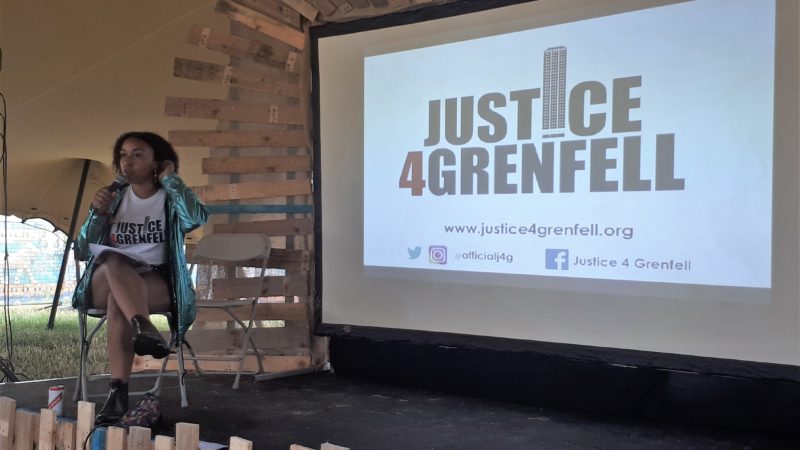14 months on, there is still no justice for the victims of Grenfell - and many social housing tenants remain at risk.

In the days following the Grenfell Tower disaster, communities rallied round to support the many victims, including offering up accommodation. It was a stark contrast to the council’s response.
“The days following were an absolute shambles. There was no organisation in place,” says Tasha Brade, a local resident.
Recognising the huge flaws in provision, she started volunteering in the area. “Then an anger hit me. I kicked into action,” says Brade. “I’m still angry.”
Until a year ago, the Ladbroke Grove resident – living near Grenfell Tower – had done no public speaking. Now she leads on communications for the Justice4Grenfell campaign. Her anger was channeled into political action.
Brade and the team will not stop until they get justice: “I need to be fighting for my people, for my area, for innocent people who’ve lost their lives.”
It hasn’t been an easy road. Like many, she has been affected by Post Traumatic Stress Disorder – something not helped by an at-times hostile media.
“Sometimes the press come after you,” she told those at Boomtown festival at the weekend (punters soon filled the Speaker’s Corner stage to listen). “You know you’re trying to do the right thing but the Daily Mail doesn’t always put it like that.”
For her, the issue revolves around a basic principle: “Decent homes are a right not a privilege. You deserve to live in a safe home – wrapped in a material that isn’t going to kill you.”
That basic principle was recognised by campaigners before the fire struck. In November 2016, Grenfell Action Group wrote:
“It is a truly terrifying thought but the Grenfell Action Group firmly believe that only a catastrophic event will expose the ineptitude and incompetence of our landlord.”
Only half a year later, in June 2017, Grenfell Tower burned for around 60 hours, killing 72 people.
The warnings were ignored. And that partly stemmed from a denigration of social housing tenants, says Brade. “The cladding was [put there] to soften look of the block for those in wealthy areas. Social housing is not a priority for the council.”
Yet the government’s inquiry into the fire has excluded key reference points – such as the stigma around social housing and its tenants.
“Those in social housing are treated as scroungers. Yet the first people to help were young Muslim men, and young black boys. There were soldiers, seamstresses and artists in there.”
Nearly 14 months later, many residents are still in temporary accommodation. Dozens are understood to have attempted suicide. And the NHS is said to be treating thousands in the local area suffering from trauma.
And yet, there is a real risk a tragedy on this scale could happen again. Tests after the Grenfell fire showed that 474 high-rise residential blocks and publicly owned buildings – in England alone – have the same type of flammable ‘aluminium composite material’ cladding that was used on Grenfell. Many are still awaiting building works.
And while combustible cladding will be banned for high rises, hundreds of other buildings remain at risk – as will many more new-builds in future, according to MPs.
As Matt Wrack, General Secretary of the Fire Brigades Union, has noted, Britain’s privatised fire safety regime is partly to blame:
“Every aspect of fire safety in the tower – the safety measures designed and built into the fabric of the block in 1974 – all spectacularly failed. The fire lifts did not work. The fire doors were not of the correct standard. The smoke extraction did not work. The windows failed. The water supply was inadequate.”
For Tasha Brade and Justice4Grenfell, this means there is “still the risk of hospitals and schools becoming the next Grenfell tower.”
Campaigners are not hopeful about the chances of justice through the government’s current inquiry – and progress is extremely slow. There have been just three police interviews under caution since the blaze.
But what would justice look like? Who is responsible?
Speaking to Left Foot Forward, Brade said: “Overall the system is responsible: hundreds of companies were involved in the refurbishment of Grenfell….The council were responsible. The Kensington and Chelsea Tenant Management Organisation were responsible…The government should be held accountable for the cuts to the fire services.”
And there were arguably criminal errors. “The initial plans were to use non-flammable cladding. That was overridden. Who made that decision?” she asks.
The search for justice is difficult given the number of people involved. But the lesson of the campaign so far has been: “If you believe in anything, stand for it. And if we all speak up together, we have a louder voice.”
There are still hundreds displaced and homeless, and thousands traumatised, while others are still living with flammable cladding.
The role of Justice4Grenfell, then, is “to keep the story going – and speak up for those who aren’t there anymore.”
Grenfell Tower still stands, as a reminder that this is not over. Campaigners will keep standing and marching to ensure another tragedy like that we saw in June last year never happens again.
Josiah Mortimer is Editor of Left Foot Forward. Follow him on Twitter. He was reporting from Boomtown festival at the weekend.
To reach hundreds of thousands of new readers and to make the biggest impact we can in the next general election, we need to grow our donor base substantially.
That's why in 2024, we are seeking to generate 150 additional regular donors to support Left Foot Forward's work.
We still need another 124 people to donate to hit the target. You can help. Donate today.



